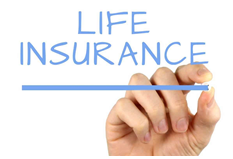The Benefits of Life Insurance When You Have a Baby
When you have a child, you want to provide for them throughout their life. Still, nothing’s guaranteed. What if your death leaves that child without the benefits you could have provided? With life insurance, you can go a long way toward protecting your children. How can your policies benefit their security?
If you’re not there to do it yourself, your life insurance might step in to help protect a dependent. As such, if you were to die suddenly, your income would likely dry up. This might leave your child without the means to support themselves. The settlement from your life insurance can likely help your child get critical funds. Essentially, it can provide your child the money you would have brought in otherwise. Your policy might

-
Establish a trust to help a new caregiver, like a foster parent or relative, provide for the child
-
Allow the child to receive income from a trust when they reach a certain age.
In many ways, your child can benefit from your policy without limitations. Still, if you set up your coverage with care, you can likely guarantee the money goes to the right places.
Let your insurance agent guide you through the process. Remember, the earlier you enroll, the more likely you are to get the best prices and coverage options. Therefore, don’t let yourself go too long without protection. After all, your family will thank you for this coverage.
Understanding Common Homeowners Insurance Exclusions
Most people purchase homeowners insurance because the mortgage lender requires it. While you may be aware of how homeowners insurance can benefit you, do you know what your policy excludes?
Standard Homeowners Insurance Does Not Cover Flood Damage
There is a general rule of thumb about coverage for water damage to your home. If the water causes damage before it hits the ground, it's normally covered. Water damage caused by flooding is not covered in a standard policy. An exception to this rule would be flooding caused by a pipe bursting in your home. If you live in a flood-prone area, your mortgage lender may require you to buy flood insurance. If not, it is relatively inexpensive and can be purchased through your agent.
 Damages Caused by Improper Maintenance are Not Covered
Damages Caused by Improper Maintenance are Not Covered
One of the most common misconceptions involves roof damage. If your roof is damaged by hail or a windstorm, it is normally covered. If your roof has just become ineffective due to wear and tear over the years, the damage is not covered. Normally, damage caused by improper maintenance of electrical systems or plumbing will not be covered. There may be exceptions here, so check with your agent.
Coverage for Certain Items of Personal Property May Be Limited
Some standard home policies provide limited coverage on certain items of personal property in your home. If you own very expensive collections of jewelry, electronics, guns, fine art or other collections, you will need to purchase additional coverage to adequately protect these items. Your insurance agent will advise you on whether it is best to purchase a policy endorsement or a separate policy.
Liability Coverage Protects Visitors, Not Members of Your Household
The liability coverage included in most standard
home insurance policies is designed to offer limited protection in the event a visitor suffers accidental injury while on your property. It does not cover you or members of your household. There may be circumstances at your home that will make liability coverage unavailable to you. Many insurance companies will not cover accidents caused by trampolines or certain breeds of dogs.
While
homeowners insurance doesn't cover everything, you can best protect your most valuable assets by taking the time to understand the types of coverage you have and working with your agent to make sure they stay up to date.
Ask us about the details of your policy. Call us today for more information on
home insurance.
Car Insurance: Liability vs. Comprehensive
If you're going to operate a car, most states require that you have car insurance. In some, the state will even tell you what type and how much insurance you should have. There are two main types of car insurance: liability and comprehensive. In states where you have a choice about whether you're going to have comprehensive insurance or not, it's important to understand what each type covers so you can make an informed decision.
What Liability Insurance Covers
Liability insurance covers damage you might cause in an accident (and injuries to the other driver or passengers). For instance, if you fail to stop in time and damage the bumper on the car in front of you, your liability insurance can pay for the damage you caused to the other vehicle. However, liability insurance will not cover any damages to your own vehicle. This means that if your front bumper was also damaged in the above accident, liability insurance is not going to pay for it.
What Comprehensive Insurance Covers
Comprehensive insurance is a great addition to a car insurance policy that includes collision and liability coverage. It covers damage to your car caused by things like hailstones, vandalism and even theft. This may also cover collisions with animals and stationary objects, like trees or fences.
Which Should You Choose?
Aside from the legal requirements of your state, which type of insurance is best for you? The answer depends on several factors, including how old your car is and how long you intend to keep it. With a very old car that you don't plan to keep much longer, liability insurance is usually more than enough. Also, if you happen to live in a high crime area, you might want to have comprehensive insurance to protect you in case of car theft.
Get the coverage you need. Call us today for more information on auto insurance.
Review Your Home Insurance For Coverage Limits
Having homeowners insurance on your property is essential to your own security. After all, it helps you both maintain your property and protect your finances in case of hazardous accidents. 
However, in order to perform optimally, your policy must be tailored to your property, specifically. You must choose coverage options that will address the risk factors that are most likely to occur in your home. This can change from one property to the next. And, periodically, you will have to update your existing coverage to ensure you are still receiving optimized benefits.
Here are a few things to remember when reviewing your homeowners insurance this year.
Does the Policy Cover Home Updates?
When you build a new addition to your home, renovate a portion of the home, or even install new features like new doors and windows, you add value to the home. You also can chance the safety risks and other liabilities associated with the home. Therefore, your current limits within your property and liability insurance might not be adequate for you.
Have you Bought New Possessions?
Your homeowners insurance will include contents coverage designed to insure your personal belongings. However, if you have bought a lot of new or high-value possessions, then you might need to buy increased coverage. This is particularly important if you plan to insure unique or valuable items, such as collectibles or art. These items might need to be scheduled on your plan for their specific values.
Are There Exclusions on the Policy?
Home insurance policies won’t cover every instance of property damage. Indeed, they will often specifically exclude certain hazards from coverage, namely floods or normal wear & tear. In the former case, floods must be covered with separate flood insurance. In the latter case, normal wear & tear will not fall under most policies’ definitions of covering unexpected or unavoidable accidents.
Do You Have Enough Liability Insurance?
If something happens to a third party that is your fault—for example, if a neighbor falls in your home and gets hurt—then you might have a legal responsibility to repay them. Under the circumstances, liability insurance is the component of your homeowners policy that will help you do so.
Your liability insurance policy will need to minimize your personal financial loss from any liability lawsuit, which can often lead to hundreds of thousands of dollars in costs as you work to settle the charges. Therefore, it’s often recommended that you carry as much liability insurance as reflected by your net worth. Additionally, if you live in a home where you know there are significant liability risks present, then having additional liability insurance can be of merit.
The best thing to do to ensure you have appropriate amounts of homeowners insurance, just contact your agent. We’ll help you determine where your policy leaves room for improvement, and guide you through the process of making the appropriate changes.
Is the Life Insurance I Have Through Work Enough?

What is group life insurance?
If you have life insurance through your job, that’s technically called “group life insurance.” It’s offered to employees as part of a benefits package, usually along with things such as health insurance and short-term disability. One of the biggest advantages of a group life insurance policy is that it’s low-cost to employees or group members, so you can get coverage at a much lower rate — sometimes even at no cost — than if you were purchasing an individual policy. However, it’s important to look at what type of coverage you’re getting in return and make sure that it’s enough to meet your needs.
Is group life insurance through work enough?
“Something that we see very often is that people don’t know what’s an appropriate amount of coverage to have when it comes to life insurance,” says Scott Limes, life product manager at Nationwide®. “One person may be married with seven kids, someone else might be single and not have any dependents. Everyone on the policy is at a different stage in their life, but there’s not a lot of time or education set aside to look at what is provided.”
Adding to the challenge is the fact that, typically, employees are choosing their group insurance coverage on an annual basis during an enrollment period. They’re making multiple decisions about what kind of health insurance, vision plan and long-term disability insurance they want to include, often without much time or outside information.
“At that point, there’s not a lot of education about how the policy works and what they’re actually getting,” Limes says. “For example, what happens beyond this enrollment time? Are they getting a competitive rate? In some cases, they may be able to get that same amount of coverage for less money.”
When does group life insurance end for an employee?
“A group policy is not going to have the same benefits and support as an individual life insurance policy,” explains Limes. “The biggest thing that we see is that people have a lack of understanding about what that policy offers. If something happens, how much will go to their family? Will it be enough? What happens if they lose their job? These are things that are really important in the long run but oftentimes aren’t discussed.”
Like everything in life, there are pros and cons you should weigh when considering a group life insurance purchase. Most importantly, your group life insurance policy doesn’t move with you if you leave your job for any reason, including if you’re laid off. So if you change employers later in life, it can be harder to get the coverage needed —especially if you develop a health condition.
Steps to take before you enroll
Step 1: Get an estimate of how much coverage you and your family need.
You can use an online calculator to get an estimate of the coverage amount you need. This will help you understand how the money from the policy claim could be used (children’s education, payoff of a mortgage, payoff of high-interest debt, etc.), which affects the amount of the policy you purchase.
“A lot of times, people really underestimate how much life insurance they need,” Limes says. “But the time to learn how much life insurance is really required is always before you need it.”
Step 2: Find out the details for your group plan from your employer. This not only includes the payout amount, but how a claim is filed and how the policy amount is paid out.
Step 3: See if there is a gap in coverage amount based on how much protection your loved ones need versus what the group plan pays for.
Step 4: If there’s a gap in coverage, get an online quote to find out how much a personal policy would cost — either to supplement your group life policy or in place of it.[vi]
Step 5: Work with an insurance professional to review your information and purchase a policy, if needed.
There’s an advantage to working with an agent for your life insurance needs. Not only can they make recommendations, they can also help adjust your coverage as you move into different life stages. In addition, they can help empower you with the right questions to ask your employer about your group life coverage.
“It comes down to being able to know that if something happens to you, the things that are important to you are taken care of. This is about being able to find something that provides a level of coverage that gives you peace of mind about the future,” Limes says.
I Don't Have Flood Insurance. Do I Need It?

Here are some facts that most people do not realize when it comes to flood:
-
Floods are the nation’s most common and costly natural disaster and cause millions of dollars in damage every year.
-
Homeowners and renters insurance does not typically cover flood damage.
-
Floods can happen anywhere–More than 20 percent of flood claims come from properties outside the high risk flood zone.
-
Most federal disaster assistance comes in the form of low-interest disaster loans from U.S. Small Business Administration (SBA) and you have to pay them back. FEMA offers disaster grants that don’t need to be paid back, but this amount is often much less than what is needed to recover. A claim against your flood insurance policy could and often does, provide more funds for recovery than those you could qualify for from FEMA or the SBA–and you don’t have to pay it back.
If you’re thinking about buying flood insurance, you may want to know a few things before you jump in. Flood insurance is available for commercial, home and property coverage. There are 3 main components to each policy:
-
Building coverage pays to repair or replace the insured building and its foundation, electrical and plumbing systems, central air conditioning, furnaces and water heaters, refrigerators, stove, built in appliances and most other permanently installed items.
-
Contents coverage provides payment for the contents of your home or building, such as clothing, furniture, electronic equipment, portable appliances, and larger removable items like washers and dryers.
-
Replacement cost is a valuation method for establishing the value of insured property for purposes of determining the amount the insurer will pay in the event of a loss. It is typically defined as the cost to replace the damaged property with materials of like kind and quality, without any deduction for depreciation.
Basic building coverage is available up to $250,000 for home and up to $500,000 for commercial, while basic contents coverage is available up to $100,000 for home and $500,000 for commercial.
When you speak with your agent, you may decide that you need more coverage than is available in the basic plans. If so, you may opt for an ‘Excess Flood Policy’, which covers damage over and above your standard policy.
Clear as mud? Of course it is! We will lead you through the murky waters of flood insurance so that you can see how the pieces fit together and get the best coverage for your money.